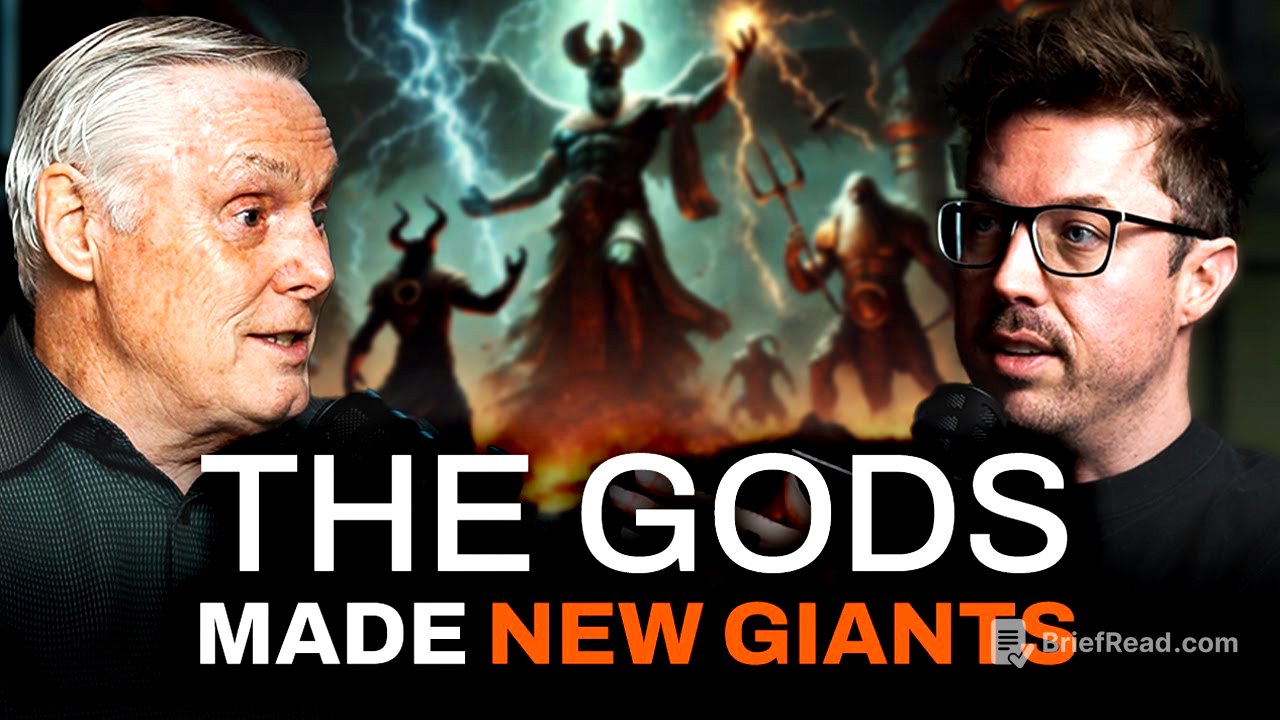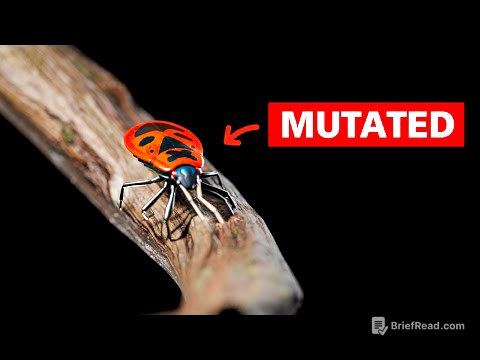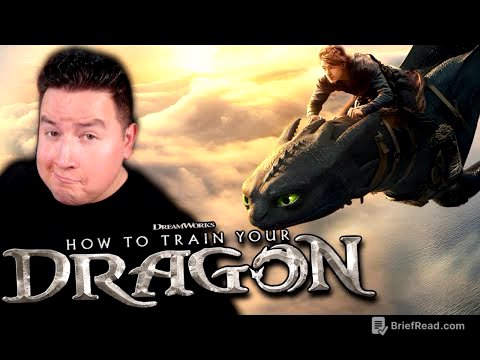TLDR;
This episode features Gary Wayne, author of "The Genesis 6 Conspiracy" book series, discussing various topics including the historical and biblical perspectives on the Flood, the Epic of Gilgamesh, the second incursion of fallen angels, the lineages of giants, the RH negative bloodline, the Anunnaki and Watchers, Nimrod's lineage, Abraham's journey, the roles of Jehovah and Elohim, Gnostic beliefs, and how to guard against deception. The conversation aims to clarify these complex subjects, providing a contrarian yet biblically grounded perspective.
- The Flood is a common legacy found in various cultures and religions, seen through different lenses.
- Giants were created to prevent humankind from reaching its destiny of becoming like angels.
- The Rh-negative bloodline is linked to giant DNA and may have certain enhancements.
- The Apostle Paul is defended against accusations of heresy, affirming his consistent testimony of Jesus' deity.
- Gnostic beliefs and the New Age movement are discussed as attempts to deify Jesus and rewrite history.
Exploring the Flood: Historical and Biblical Perspectives [5:26]
The flood is a shared historical event across various cultures, found on every continent except Antarctica, and is present in almost all religions. The narrative is strikingly similar, viewed through both polytheistic and monotheistic lenses. The Epic of Gilgamesh, with tablets dating back to 2150 BC, presents a polytheistic account of the flood, featuring giants and gods. The biblical account, received by Moses during the Exodus (around 1400-1450 BC), offers a monotheistic perspective. The polytheistic accounts often depict the flood as a giant survival story, while the biblical account focuses on human survival.
The Epic of Gilgamesh [10:50]
The Epic of Gilgamesh tells a flood story through a polytheistic lens, where Gilgamesh, offspring of the goddess Nin and King Lugabanda, and Enkidu are two-thirds god and one-third human. Utnapishtim, the Sumerian Noah, is also described as a Nephilim. The Greek version features Deucalion, son of Prometheus (a god or fallen angel), as the equivalent of Noah. These accounts highlight giant survival rather than human survival. The Bible contains references in Psalms, Job, and Isaiah that suggest a conflation of catastrophes during the flood, including volcanoes and earthquakes, aligning with polytheistic accounts.
The Second Incursion & Post-Flood Giants [35:11]
The second incursion refers to fallen angels recreating giants after the flood. While the term isn't explicitly in the Bible, it suggests that other fallen angels continued to create giants out of spite. The term "Nephilim" is used to describe giants before the flood, while "Raphaim" is used for giants after the flood. In Numbers 13:33, the scouts' evil report mentions Anakim, descendants of giants, using the Hebrew word "Nephilim" to instill fear. Deuteronomy 2 lists various giant tribes after the flood, such as the Oorim, Emim, and Zamzumim, using the term "Rapha" or "Raphaim."
Post-Flood Giants and Their Lineages [41:59]
The Raphaim are distinct from the Nephilim, with the Ugaritic texts suggesting that offspring gods created Raphaim after the flood. These Raphaim giants had fertility issues, unlike the Nephilim. Goliath is identified as a son of a giant, with four other giants from the same father. Genesis 14 mentions a war of giants involving the Raphaim, Horeim, and Amalachim.
Tribes and Patriarchs of Giants [42:51]
The Amorites, listed in Numbers 13, are among the 12 patriarchless tribes of the Canaanites in Genesis 10 and 1st Chronicles. Unlike other tribes with patriarchs, these are eponymously named after Raphaim giants who intermarried with females. Genesis 36 highlights intermarriage between Raphaim patriarchs and females, creating new dynasties.
Intermarriage and Hybrid Giants [43:47]
Intermarriage and hybridization were common, with Hittites and Canaanites understood as hybrid giant-like people. Canaanites, Sidonians, and Hittites are described as larger and greater than the Israelites. These hybrids were typically 7 to 9 feet tall, smaller than the 11 to 16 feet Nephilim.
Fertility Issues and Dynasties [46:58]
The special race of giants after the flood had fertility issues, particularly with producing females, leading to interbreeding with humans to avoid extinction. The matriarchy bloodline is significant in occult and royal circles because it is how new dynasties are started.
Speculations on Fallen Angels [48:53]
After the second incursion, there were more restrictions and less interaction permitted between fallen angels and humans. Gods like Baal and Zeus disappeared due to committing similar crimes as before the flood. The council of gods still exists, with Satan as the prince, but crossing certain lines results in imprisonment in the pit.
Biblical and Mythological Connections [50:55]
Fallen angels and gods could have up to seven different names. Baal, meaning Lord God or master God, is closely related to Raphael, meaning healer of God. Fallen angels had the ability to pass on their gifts, and the tribe of giants called Raphaim seemed to have that eponymous name.
RH Negative Bloodline and Giants [55:07]
Having giant DNA is not a cause for concern, as approximately 15% of the population possesses it, often manifested through the Rh-negative blood gene. This gene, associated with the matriarchal bloodline, is linked to the pale or albino skin and lighter hair prized within royal cultures. NASA has researched Rh-negative blood, associating it with higher IQs, intuition, and spiritual phenomena. The heaviest concentrations of Rh-negative blood are found in royal families and the Basque people, who claim to have survived the flood and originated from Atlantis.
Anunnaki and Watchers [1:03:06]
The Anunnaki are two groups: those of heaven (gods or fallen angels) and those of earth (giants), both considered watchers in Sumerian history. Seraphim angels are serpent-faced, six-winged dragon angels, while cherubim have faces of a lion, human, bull, and bird. These watchers influenced the creation of various beings, such as bird-faced offspring in Southeast Asia and lion-like men. Superheroes are based on giants and the technology used to grant them superhuman attributes.
Nimrod's Lineage [1:17:45]
Nimrod, son of Kush, is called the mighty one (Gibbor), a term also used to describe giants. He likely intermarried with a giant or fallen angel, though this isn't explicitly stated in the Bible. Many royal bloodlines trace back to Nimrod, who holds a special place in Sumerian and post-diluvian history.
Nimrod and Abraham: A Historical Breakdown [1:22:29]
Abraham was a Semite and the only monotheist of his time, selected by God and moved away from Nimrod and the land of giants. He remained loyal despite intimidation and peer pressure, becoming the inheritor of the covenant and promises.
Abraham's Journey and Faith [1:23:52]
Abraham's story is one of incredible faith and testing. He lived among giants and was tested many times, remaining loyal to God. He received blessings from Melchizedek, the king of righteousness, who has no genealogy.
The Role of Jehovah and Elohim [1:26:37]
Jesus, referred to as Jehovah of the Elohim in the Old Testament, is the cognate term for the word of God (logos of theos). He is part of the Elohim, which includes the spirit, the word, and the father. Jehovah is the pre-existent Jesus, the spiritual nature that interacts with key figures throughout the Bible.
Gnostic Beliefs and the Apostle Paul [1:34:11]
To bring in the universal Babylon religion, Jesus must be deified. Polytheists and Gnostics claim that only Paul elevated Jesus to deity status, but Matthew, Mark, Luke, and John also testify to Jesus' divinity. Gnostic Christians view Jesus as a verified historical figure but not God immortal, similar to Confucius or Buddha. They draft Jesus into their polytheistic framework while dismissing inconsistent biblical passages.
Reimagining History and Prophecy [1:46:43]
Gnostics and polytheists rewrite history to reinterpret and reclassify events. They claim Moses was a royal educated in Heliopolis, bringing Egyptian religion rather than monotheism. This reinterpretation aims to undermine Judaism and Christianity. They also attempt to deify Jesus by presenting falsified genealogies and ancient documents claiming he survived the crucifixion and had offspring.
Guarding Against Deception [1:56:40]
To guard against deception, it's important to recognize red flags such as reimagining the Bible, attacking personally instead of addressing scripture, and using the "chase the rabbit" argument. Truthful individuals use scripture to make their points and address inconvenient passages. The interpretive approach, common in polytheism, should be avoided in favor of a literal approach to understanding the Bible.
Final Thoughts and Encouragement [2:04:40]
The enemy is organized and well-informed, knowing more about the Bible than many. It's important to reconcile inconvenient passages and test the spirit, as demonic spirits can masquerade as angels of light. The signs from God, such as the three days of darkness and the sun standing still, cannot be counterfeited by fallen angels or occult science.









